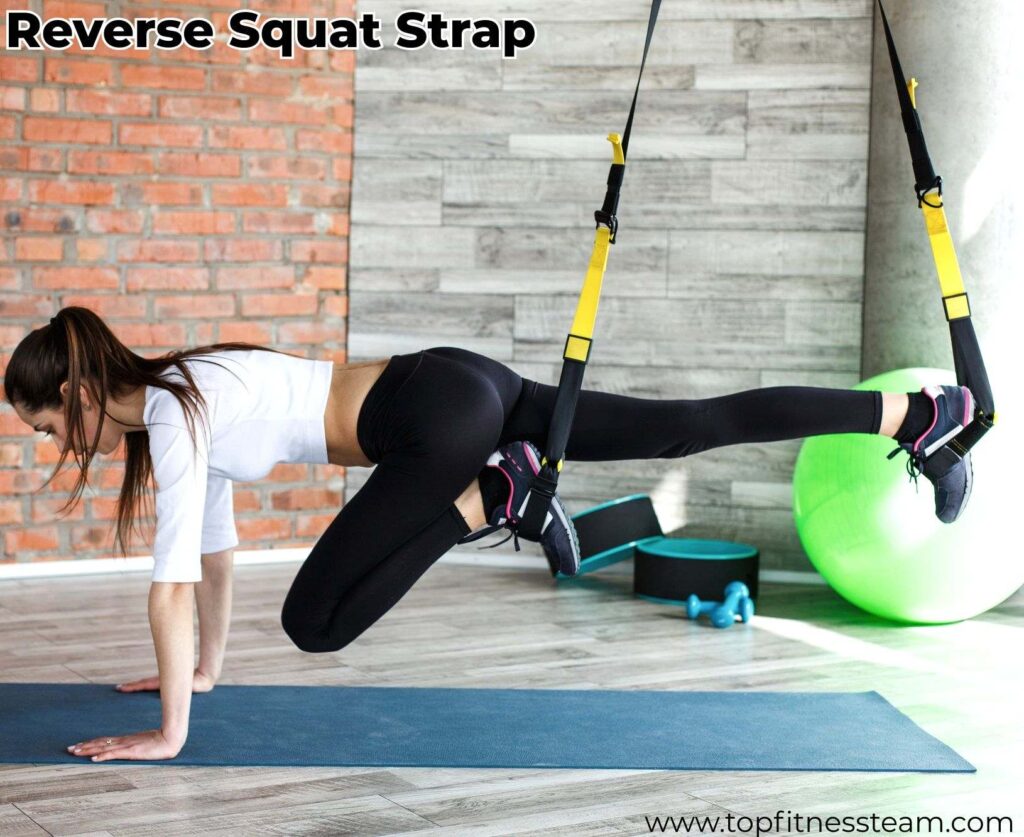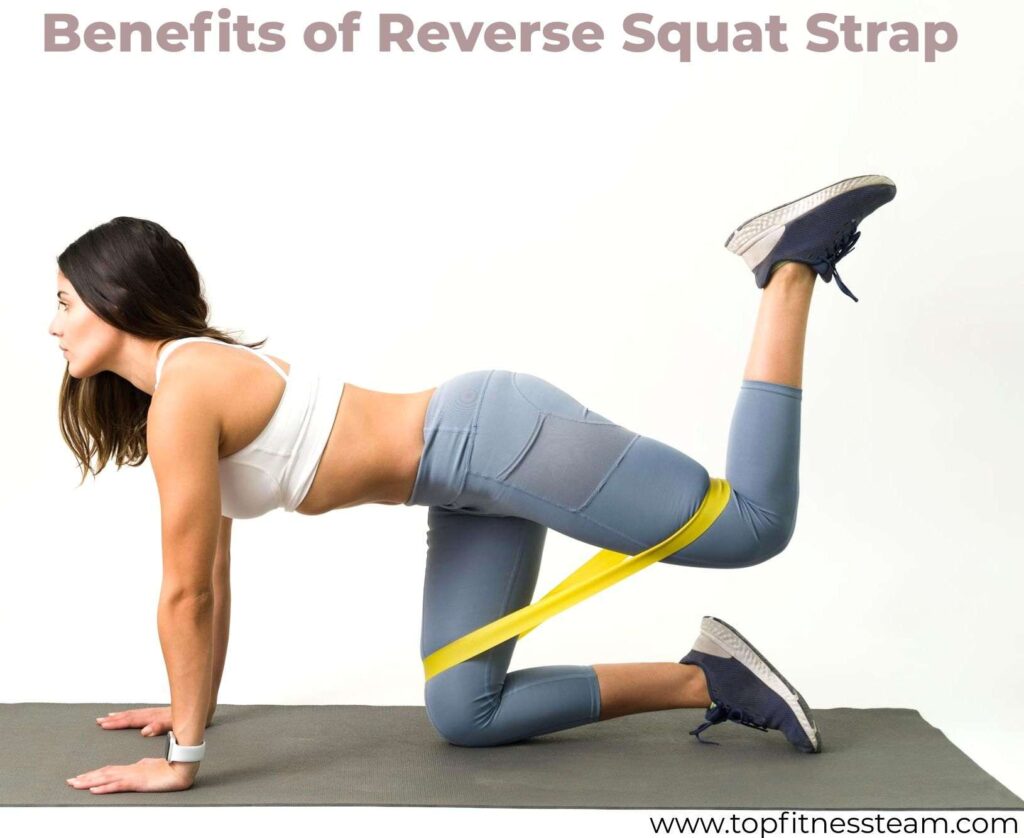Hello everyone, Top Fitness Team is here. This article will tell you about Reverse Squat Strap.
Introduction
In the quest for peak physical fitness, the reverse squat has appeared as a cornerstone exercise, lauded for its ability to sculpt and support.
Amidst this backdrop, the reverse squat strap strides into the limelight, marrying creation with the timeless squat to revolutionize workout routines.
This blog post delves into the essence of the reverse squat strap, mining the myriad of benefits it brings to both novices and seasoned athletes alike.
What is Reverse Squat Strap?
The reverse squat strap is a technical fitness accessory to boost the squatting experience. Unlike traditional kit, this strap features durable, non-slip webbing that ensures stability and uniform pressure distribution during a workout.
The belt often includes neoprene padding for enhanced comfort and a heavy-duty D ring to secure the strap, facilitating a squat variation that highlights proper knees-over-toes alignment.
The design not only mitigates the risk of injury but also maximizes the attention of crucial muscle groups.
Benefits of Reverse Squat Strap
Employing a reverse squat strap in your regimen offers an overload of benefits. It enables an optimal knees-over-toes position, which is pivotal for joint health and muscular balance.
This alignment helps cultivate stronger hip flexors, essential for explosive movements and lower body strength. For beginners, the strap provides a supporting structure to master the squat form.
At the same time, advanced athletes can challenge their limits safely, aiming for deeper squats and increased opposition.
How to Use Reverse Squat Strap
To utilize a reverse squat strap, secure the strap around your thighs, just above the knees. The neoprene padding is comfortable, and the heavy-duty D ring is fastened correctly.
As you descend into the squat, the strap will assist in keeping your knees over your toes, a crucial aspect of the movement. For those visual learners, glancing at the NEW RED Reverse Squat Strap could be invaluable.
How does the reverse squat work?
The reverse squat is a compound movement that primarily engages the lower body muscles, focusing on the glutes, quadriceps, and hamstrings.
By stepping backward and lowering into a lunge it offers a dynamic range of motion that also calls upon the calves and hip flexors. This variation of the standard squat not only builds strength and perseverance but also enhances stability and balance.
Also, the core muscles are activated throughout the exercise to maintain stance and stability, providing a complete lower-body workout.
Reverse Squat Strap Exercises
The versatility of the reverse squat strap allows for various exercises beyond the traditional squat. Include lunges to target different muscle groups or attempt a squat hold to build constancy.
For a comprehensive guide on leg-building workouts, V Squat Machine Workouts: Building Stronger Legs provides excellent insights. The strap offers each movement precision, highlighting the importance of proper form.
Safety Precautions and Tips
When utilizing the reverse squat strap, safety should never be compromised. Always perform a proper warm-up to prepare the muscles for exercise.
Be mindful of the strap’s tension and adjust accordingly to avoid undue strain. It is also vital to prevent exceeding the knees past the toes, which can lead to injury.
For other squat variations that prioritize safety, How to Perform Sissy Squats Benefits and Pros & Cons is an instructive read.
Comparing Reverse Squat Strap to Other Squat Aids
The reverse squat strap stands out from other squat aids due to its simplicity and efficacy. While squat racks and resistance bands have their place, the belt offers a unique blend of support and freedom of movement.
To gain insight into alternative squat techniques and their benefits, exploring Arsenal Hack Squat Explained can widen your squatting repertoire.
User Experiences and Testimonials
Testimonials from users of the reverse squat strap often highlight its impact on their training and the apparent improvement in their squat form. Such favors serve as a testament to the strap’s efficacy.
Stories of change, where users overcome plateaus and achieve new personal bests, underscore the strap’s role in advancing fitness goals.
Purchasing Guide
Selecting the right reverse squat strap entails considering the quality of materials, such as the non-slip webbing and neoprene padding, and the strap’s overall durability.
Opt for reputable brands that deliver on these aspects, and consider the NEW RED Reverse Squat Strap for a tried and tested option.
Maintenance and Care for Reverse Squat Strap
To maintain the longevity of your reverse squat strap, regular care is essential. Post-workout, wipe down the neoprene padding to prevent the buildup of sweat and bacteria.
Inspect the heavy-duty D ring and webbing for any signs of wear and tear to provide safety during your workouts.
Summary
The reverse squat strap is a beacon of ingenuity in the fitness domain, offering a safe and effective way to improve your squatting technique.
Its simple design, coupled with its profound impact on form and muscle attention, makes it a vital tool for anyone looking to boost their lower body workouts.
My Final Thoughts
Reverse squat strap is a game-changer for those looking to refine their squat technique and support lower body strength.
Its design promotes proper alignment, improves safety, and adds a layer of opposition to traditional squats. Whether you are a fitness lover or a skilled athlete, including the reverse squat strap into your regimen could be the key to unlocking new levels of routine and strength in your lower body workouts.
FAQs
Q: What is the difference between reverse and regular squats?
Ans: Regular squats involve lowering the body by bending the knees. At the same time, the feet remain stationary. In contrast, reverse squats involve footing one leg backward into a lunge position while performing the squat.
Q: What are the benefits of the reverse squat strap?
Ans: The reverse squat strap helps provide proper form, supports the knees-over-toes alignment, and can improve the activation of hip flexor and lower body muscles during squats.
Q: Why do people use the V squat backward?
Ans: People use the V squat machine backward to shift the focus onto the glutes and hamstrings, providing a different angle and muscle activation compared to the traditional forward-facing position.
Q: How do you do reverse squats?
Ans: To do reverse squats, stand with your feet shoulder-width apart, then step backward into a lunge position, rotating your legs while maintaining an upright torso and providing your front knee does not extend past your toes.
Q: What is the difference between squats and reverse squats?
Ans: The main difference lies in the movement. Traditional squats involve bending at the hips and knees to lower the body. In contrast, reverse squats (lunges) involve stepping one foot back and lowering the hips towards the floor.
Thanks.

